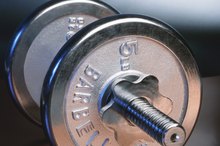Sneezing & Groin Injury
Sneezing seems like an annoying but generally harmless event, but it can aggravate pain elsewhere in the body and cause some painful conditions. Sneezing can lead to a rupture, called a hernia, in your abdominal wall or upper thigh near the groin. It can also create twinges of pain if you have a thigh muscle condition called Gilmore’s groin. If you have groin pain, however, don’t try to self-diagnose--see your doctor.
Sneezing’s Effects
The jolting, contracting movement of a sneeze can cause an injury by tearing open any weak spots in the muscles surrounding the groin. This type of injury is called a hernia. The rip allows a portion of an abdominal organ, such as part of the intestines, to protrude out past the opening and create a lump. Hernias can occur during other trauma or movement as well, and the force of a sneeze or repeated sneezing can cause you to feel pain in the already injured groin, regardless of the cause of the injury.
More men than women get hernias, though anyone can develop one if conditions are right. Sneezing can also result in groin pain if you have a muscle injury called Gilmore’s groin, in which the inner thigh muscle tears near the groin area.
- The jolting, contracting movement of a sneeze can cause an injury by tearing open any weak spots in the muscles surrounding the groin.
- Sneezing can also result in groin pain if you have a muscle injury called Gilmore’s groin, in which the inner thigh muscle tears near the groin area.
Specific Injuries
Groin Pain After Golf
Learn More
Inguinal and femoral hernias are the two types of hernias that affect the groin area. Inguinal hernias occur along the inguinal canal, which connects the lower abdominal cavity and the groin. The inguinal canal contains a uterine support ligament in females and the vas deferens in males. Massachusetts General Hospital says femoral hernias occur “slightly below the groin,” and females are more likely to have femoral hernias than males 2. Both hernias result in a bulge that can sometimes be pushed back in. Massachusetts General Hospital says this bulge may be painless in adolescents, but the Mayo Clinic says that in general they can be painful 2.
- Inguinal and femoral hernias are the two types of hernias that affect the groin area.
- The inguinal canal contains a uterine support ligament in females and the vas deferens in males.
Possible Confusion
A smaller version of an inguinal hernia found in athletes is called a sports hernia 3. Sneezing doesn’t cause these, but the force of the sneeze can cause the injured area to hurt. The University of Maryland Medical Center says sports hernias are usually the result of a lot of twisting and turning motions placing stress on the abdominal wall 5. SportsInjuryClinic.net says Gilmore’s groin is sometimes called sportsman’s hernia, despite not actually being a hernia 4. Do not confuse this with a sports hernia, which is located in the abdominal region and not the thigh muscles.
Cautions and Treatment
Testicular Pain After Sit-ups
Learn More
Hernias that aren’t treated correctly can become incarcerated, in which the bulging part of the intestine is “trapped” in the hernia opening, as the Mayo Clinic notes 3. This closes off the section of intestine and creates an intestinal obstruction that stops bowel movements. Blood flow to the trapped tissue may stop as well, killing the tissue. The treatment for a hernia is surgery and usually involves moving the tissue back into the abdominal cavity and closing the rip, either directly with stitches or by covering it with a special mesh. SportsInjuryClinic.net notes that initial treatment for Gilmore’s groin is therapy in the form of strengthening the muscle, but it may eventually require surgery as well 4. After surgery a person can expect up to six weeks of rehabilitation.
Prevention
Massachusetts General Hospital, Langone Medical Center at NYU and the Mayo Clinic all recommend learning to lift and bend correctly, losing weight and quitting smoking 2. The Langone Medical Center also recommends strengthening abdominal muscles in order to keep them strong and functioning properly. If you have been sneezing a lot, see your doctor to discuss ways to lessen the sneezing or its impact.
Related Articles
References
- Mayo Clinic: Inguinal Hernia
- SportsInjuryClinic.net: What Is Gilmore’s Groin?
- Fitzgibbons RJ, Forse RA. Groin hernias in adults. N Engl J Med. 2015;372(8):756-763. doi:10.1056/NEJMcp1404068
- Merriam-Webster Dictionary. Definition of HARUSPEX. Updated 2020.
- Mahadevan V. Essential Anatomy of the Abdominal Wall. In: Kingsnorth A, LeBlanc K, eds. Management of Abdominal Hernias. Fourth. London: Springer Science & Business Media; 2013:25-55.
- M BS. SRB’s Manual of Surgery. Sixth. London: Jaypee Brothers, Medical Publishers Pvt. Limited; 2019:739-776.
- Wang H, Naghavi M, Allen C, Barber R, Bhutta ZA, Carter A. Global, regional, and national life expectancy, all-cause mortality, and cause-specific mortality for 249 causes of death, 1980–2015: a systematic analysis for the Global Burden of Disease Study 2015. The Lancet. 2016;388(10053):1459-1544. doi:10.1016/S0140-6736(16)31012-1
- Hoffmann H, Walther D, Bittner R, Köckerling F, Adolf D, Kirchhoff P. Smaller inguinal hernias are independent risk factors for developing chronic postoperative inguinal pain (CPIP). Annals of Surgery. 2020;271(4):756-764. doi:10.1097/SLA.0000000000003065
- Dhua AK, Aggarwal SK, Mathur N, Sethi G. Bilateral congenital diaphragmatic hernia. APSP J Case Rep. 2012;3(3):20. PMID: 23061036
Writer Bio
Suzanne S. Wiley is an editor and writer in Southern California. She has been editing since 1989 and began writing in 2009. Wiley received her master's degree from the University of Texas and her work appears on various websites.









